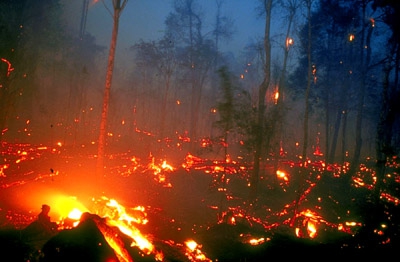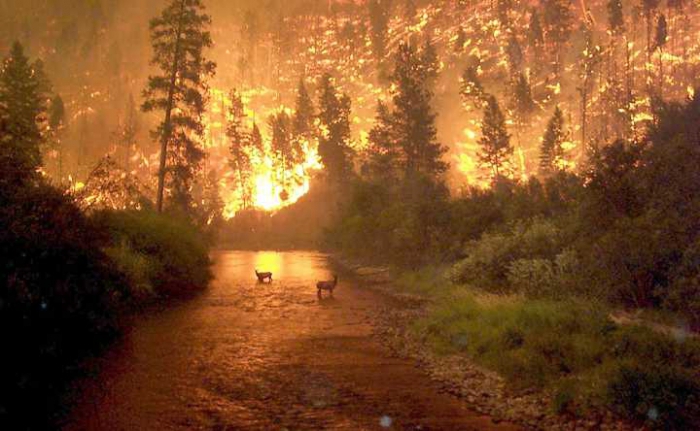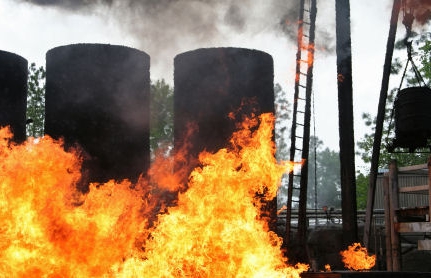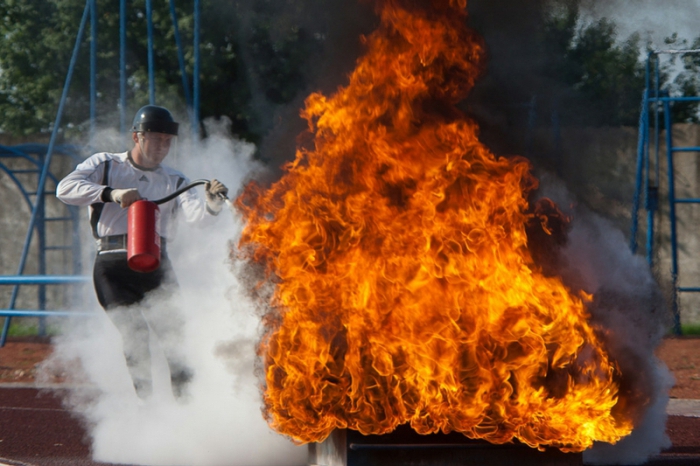Fires cause serious material damage and in some cases result in loss of life. Therefore, every reasonable member of our society must be able to defend against them. It is very important that the state in every way contributes to the dissemination of educational information on this topic. In this article we will tell you about the types of fires, as well as about preventive measures for this process. So let's get started.
The concept
A fire is a combustion process that occurs involuntarily (or by malicious intent) and continues until all combustible materials and substances are burned, or measures are taken to extinguish it, or conditions favoring self-extinguishing appear.
Conditions of occurrence
Fire occurs when:
- Oxygen contained in the ambient air.
- Fuel: furniture, clothing, bedding, a bottle of gasoline, etc.
- Heat source: electric heater, open flame, lit match.
- Man, because of which the majority of fires occur.
Fire classification
By external signs, fires are divided into hidden, open, internal, external and at the same time internal and external. Let's talk about each of them in more detail.
Outdoor
They occupy the first place in the list of “fire classes”. They can be visually identified by such signs of burning as smoke and flame. Such fires occur during the fire of buildings, peat, coal and other material assets located on open storage areas; when burning petroleum products in tanks, on open racks and process plants; grain crops, peat fields, forests, etc.
Domestic
They arise and develop exclusively inside buildings. May be hidden and open.
Open
Signs of burning during open fires can be established by inspecting the premises. For example, the burning of materials and equipment in production halls, coatings, floors, partitions, etc.
Hidden
In case of hidden fires, the combustion process occurs in ventilation ducts and mines, niches of building structures, and the inner layers of the peat deposit. In this case, smoke comes out of the cracks, the structures become very hot, and the color of the plaster changes. Fire can be seen when disassembling or opening structures and stacks.
With a change in the situation, fire classes also change. For example, internal hidden burning can develop into open. Also, internal combustion can become external, and vice versa.
Even fires are distinguished by the place of occurrence. They happen on open storage sites, in structures, buildings and on combustible massifs (peat, steppe, forest and grain fields).
In populated areas and industrial enterprises, fires can be separate (in a building or a building) and massive (a set of fires covering more than 90% of the building).
Types of fires
1. Fires in a house or building
The main cause of occurrence is inattention of a person. Failure may result in damage to electrical installations; inept and careless use of electrical appliances; spontaneous combustion of the TV, the operation of home-made electric heaters and fuses, inept electrical wiring. And, of course, a violation of the rules for operating a gas stove. Fire prevention, which is described below, will help to avoid fire.
2. Forest
Let's start with the definition. Forest fire is an uncontrolled, spontaneous spread of fire in the forest. Causes of occurrence can be man-made and natural.But the most common reason that a fire in the forest can occur is lightning. The sizes of fires can increase to such an extent that they can be viewed from space.
There are bottom and top types of forest fires. Let's look at them in more detail.
Grassroots
They are divided into fluent and stable:
- Runaway. Burn the upper part of the ground cover, undergrowth and undergrowth. Such a fire has a high propagation speed, but bypasses places with high humidity. Runaway fires are characteristic of mid-spring, when only the top layer of combustible materials dries out.
- Sustainable. They move slowly, but they do not leave the burned out dead and living ground cover over the entire burning area. At the same time, undergrowth and undergrowth completely burn out, as well as the bark and roots of trees are badly burned. Typically, such fires occur in mid-summer.
Horse
They cover branches, needles, leaves and the entire crown of the tree. Riding fire in the forest is characterized by the appearance of a huge number of sparks flying out of needles and burning branches. They are picked up by the wind and carried to the nearest territories (tens of meters), creating many lower fires. In strong winds, they can spread hundreds of meters from the main focus.

3. Steppe
Currently, these types of fires cause a lot of problems for people. And all because very little attention is paid to the development of measures to prevent and combat them. The development policy of fallow and virgin lands, practiced in the second half of the 20th century, ruined the natural steppe vegetation. This consumer attitude to the steppe phytocenoses has been preserved to this day.
Now the plowland steppes in a particular region is 60-75%. In the recent past, when the emphasis was on increasing the “sown area,” this figure reached 80-90%. That is, the increase in productivity is achieved not due to highly scientific agricultural technology, but by increasing land. Periodically, natural fires occur in the steppes, which are an exogenous environmental factor. However, human activity leads to a multiple increase in their frequency.
4. Underground
They occur during a forest fire or due to spontaneous combustion. There may also be a human factor in a swamp with the presence of a dried peat layer. Such fires are characteristic of taiga, forest-tundra and tundra, where a high content of peat deposits is observed. The depth of penetration of fire is 3 meters or more. The spread of such fires can reach several hundred meters per day.
Peat fires in artificially drained bogs have one feature: they occur due to strong heating of the surface. In addition, the duration of burning can reach several months and even years. Natural precipitation affects the dynamics of the fire only at its initial stages or in the case of low peat thickness. If fire appears inside the peat horizon, then its distribution depends on the humidity of the upper and lower layers of organic matter.
These types of fires do not have such a vast geography as the previous ones (forest and steppe). However, given the large volume of carbon emissions, they pose no less danger. Since peat has a good water-holding ability, it is very difficult to moisten the burning hearth from the outside. Therefore, to extinguish such a fire requires a lot of water. That is, this is associated with significant economic losses, as well as with a risk to people's lives. For example, in 1972, several cars failed during the extinguishing of underground fires in the Moscow region under burning peat. This led to the death of a large number of people.
5. Technogenic
This includes a fire at nuclear power plants, as well as oil, gas and gas-oil fires. During the operation of the well, fountains (pressure jets) can burst out and catch fire.They are conditionally divided into oil (gas content less than 50%, and more oil), gas (gas content 95-100%) and gas and oil (oil less than 50%, and more gas).
Oil combustion can occur in production equipment, tanks and during its spill in open areas. If petroleum products ignite in tanks, an explosion is likely. Especially dangerous are oil boils and emissions due to the presence of water in them. When boiling, the flame height and temperature very quickly increase (up to 1500 ° C). In this case, the foamed mass of the substance has a very rapid combustion process. Extinguishing a fire in this case can take quite a while. We go further.

Prevention and rules of conduct in case of fire
To prevent fire, each citizen must comply with a number of conditions for its prevention in enterprises, in residential buildings, in the forest, in the field, on peat bogs and in other places.
If we consider the objects of the national economy, then the fire regime is installed there and the corresponding instructions are written. Moreover, this is done both for the facility as a whole, and for individual sections, shops and brigades. The instructions indicate places specially designated for smoking, provide standards for storing all kinds of materials and prescribe rules of conduct in case of fire.
One of the most effective means of extinguishing fires is considered a fire extinguisher. It must be borne in mind that it is not always permissible to extinguish a fire with water. For example, a water stream cannot be directed to a burning electric wire, since a person can be shocked. After all, water is an excellent conductor. So before extinguishing the fire, disconnect the line. If this is not possible, use powder and carbon dioxide absorbers. Incendiary substances and a combustible mixture are extinguished by sand, air-mechanical or chemical foam, as well as powder mixtures.

It is better to go into a smoky room together and move around, holding on to the walls so as not to lose orientation. Before entering, you must always wear a filtered or insulated gas mask with a hopcalite cartridge. Doors in burning rooms should be opened very carefully and used as coverings. If there are people in a smoky and flaming room, then they must be taken out immediately, after having thrown a wet cloth or clothing on their heads. In the case when the exit is cut off by fire, evacuation is carried out through balconies and windows using manual, mechanical, stationary ladders and various car lifts. Rescue ropes are also used.
Field, forest, and peat fires occur due to careless handling of fire near settlements, as well as because of outstanding fires and sparks from the exhaust pipes of tractors and cars. Most easily ripened bread, coniferous forests and dry grass light up. Therefore, it is forbidden to make fire near forests, peat bogs, crops and thickets of reeds. It is also forbidden to smoke near the forest (allowed only on specially equipped sites), stacks of mowed bread and when working in cars, pick-ups, tractors and combines. Each machine must have a spark arrester.
Fire Hazards
1. The effect of toxic combustion products
In the construction of modern buildings, synthetic and polymeric materials are actively used. If a fire occurs, a person will certainly experience the effects of toxic products released during their fire. Combustion products may contain up to 100 types of chemical compounds with harmful effects, but most often the cause of death is carbon monoxide. It reacts with hemoglobin 200 times more actively than oxygen. Because of this, red blood cells cannot supply the body with oxygen. According to statistics, 50-80% of people die in fires precisely for this reason.
2. Reduced oxygen concentration in the ignition zone
During a fire, the concentration of oxygen in the surrounding air is greatly reduced.Lowering the oxygen level by 3% will cause a violation of the motor functions of the body.

3. Elevated ambient temperature
If during a fire the ambient temperature is + 70 ° C, then being in this area for half an hour can lead to a burn of the respiratory tract. With an oxygen content of 6% and a temperature of 140 ° C, death occurs in a few minutes. In addition to causing burns, hot smoke greatly impedes visibility, and a person is poorly oriented in space.
4. Destruction of buildings
Some types of fires even destroy buildings that do not burn in a fire. If steel structures are heated to 500–550 ° C, and concrete structures to 700–750 ° C, then they will lose about 50% of their own strength. Therefore, in order to protect metal beams in houses with high floors (from 10 and above), builders use wet plaster on a grid. Metal structures are also protected with flame retardant intumescent paints that enhance fire resistance up to about 40-45 minutes.
5. Open fire
And closes the list of "fire hazard" fire. He is the most dangerous. Firstly, fire burns all property; secondly, completely or partially destroys residential buildings; thirdly, causes burns. Modern medicine has achieved great success in the treatment of burns. But, despite this, a person with a burn of the 2nd degree (30% of the body) has very little chance of survival.









